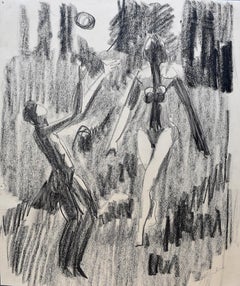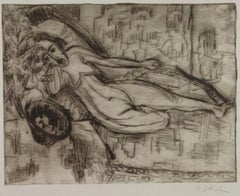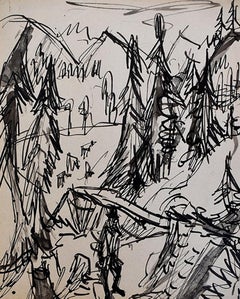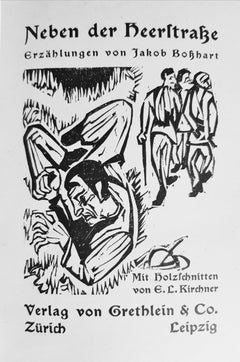Ernst Ludwig Kirchner Art
German, 1880-1938
Ernst Ludwig Kirchner (6 May 1880 – 15 June 1938) was a German expressionist painter and printmaker and one of the founders of the artists group Die Brücke or "The Bridge", a key group leading to the foundation of Expressionism in 20th-century art. He volunteered for army service in the First World War, but soon suffered a breakdown and was discharged. His work was branded as "degenerate" by the Nazis in 1933, and in 1937 more than 600 of his works were sold or destroyed.to
3
Overall Width
to
Overall Height
to
3
1
1
1
3
2
1
3
2
2
1
1
1
1
1
1
1
1
1
3
8,816
2,808
1,655
1,313
1
2
1
Artist: Ernst Ludwig Kirchner
Reclining Young Man - Pencil Drawing - German Expressionism
By Ernst Ludwig Kirchner
Located in London, GB
ERNST LUDWIG KIRCHNER 1880-1938 (German)
Aschaffenburg 1880 - 1938 Davos
Title: Reclining Young Man Liegender junger Mann, circa 1911
Technique: Pencil Drawing on Firm Wove Paper ...
Category
1910s Expressionist Ernst Ludwig Kirchner Art
Materials
Pen
Ball Playing Nudes
By Ernst Ludwig Kirchner
Located in London, GB
ERNST LUDWIG KIRCHNER 1880-1938 (German)
Aschaffenburg 1880 - 1938 Davos
Title: Ball Playing Nudes Ballspielende Akte, 1932
Technique: Chalk Drawing on Smooth Wove Paper
Paper s...
Category
1930s Expressionist Ernst Ludwig Kirchner Art
Materials
Chalk
Nacktes Liegendes Mädchen auf Diwan
By Ernst Ludwig Kirchner
Located in New York, NY
Drypoint printed in dark brown on heavy cream wove paper with wide margins. This is the third state (of four) from a small edition of only several. Signed and inscribed "II Zustand" ...
Category
1920s Expressionist Ernst Ludwig Kirchner Art
Materials
Color, Drypoint
Related Items
Aphrodite - Héliogravure and Drypoint attr. to Salvador Dali - 1963
By Salvador Dalí
Located in Roma, IT
Attr. to S. Dalì, "Aphrodite", Heliogravure and dry-point. Paris, Argillet. 1963-65.
Image dimensions 49,2 x 39,7 cm.
Beautiful Proof on vélin filigrané “Arches”, Signed and Dated...
Category
1960s Surrealist Ernst Ludwig Kirchner Art
Materials
Drypoint
$3,438
H 25.79 in W 19.69 in D 0.04 in
Emile's Tavern
By Lucien Génin
Located in London, GB
'Emile's Tavern', gouache on paper (circa 1930s), by Lucien Génin. A tavern in French is called a 'guinguette'. With the rise in living standards from the 1860s along with the develo...
Category
1930s Expressionist Ernst Ludwig Kirchner Art
Materials
Paper, Gouache
Chinatown, San Francisco
By Edward Wilson Currier
Located in London, GB
'Chinatown, San Francisco', gouache on fine art paper, by Edward Wilson Currier (1903). Spofford Alley in San Francisco's Chinatown is best known for an address (number 36) where Dr. Sun Yat-Sen plotted the overthrow of China's last dynasty. During Prohibition, it was the site of turf battles over local bootlegging and protection rackets. Today it is lined with seniors' community centres. However, the quiet alley livens up in the evenings when a Chinese orchestra strikes up a tune, mah-jongg games begin with a cascade of clicking tiles, and barbers and florists use the pretence of sweeping their doorsteps to gossip. In this artist's depiction, a man smokes a long-stemmed Chinese pipe under the awning and colourful lanterns hanging from the wooden supports while a child looks on. The artwork is interesting from several standpoints including architectural, cultural and historical. Shortly after this work was painted, the neighbourhood was completely destroyed in the 1906 earthquake that levelled most of the city. From 1910 to 1940, Chinese immigrants were detained at the Angel Island...
Category
Early 1900s Expressionist Ernst Ludwig Kirchner Art
Materials
Paper, Gouache
The Port of Le Havre
By Fred Pailhès
Located in London, GB
'The Port of Le Havre', pencil on art paper, by French artist Fred Pailhès (circa 1950s). Le Havre was only a fishing village until 1517, when Francis I h...
Category
1950s Expressionist Ernst Ludwig Kirchner Art
Materials
Paper, Pencil
Church of Saint-Nicolas du Chardonnet in Paris
By Lucien Génin
Located in London, GB
'The Church of Saint-Nicolas du Chardonnet, Paris', gouache on art paper by Lucien Génin (circa 1930s). In Paris' 5th Arrondissement the site in which Saint-Nicolas du Chardonnet is ...
Category
1930s Expressionist Ernst Ludwig Kirchner Art
Materials
Paper, Gouache
$1,748 Sale Price
20% Off
H 17.6 in W 14.06 in
Three Figures - Original Etching and Drypoint by Pierre Girieud - 1920
Located in Roma, IT
Three Figures is an Original Etching and Drypoint realized by Pierre Girieud (1876-1940).
Foxing and stains on top center.
Includes a white cardboard passpartout (69x49 cm).
Hand signed on the lower right corner.
Pierre Girieud was a French painter (Marseille 1875 - Nogent-sur-Marne 1948). Follower of P. Gauguin, friend of Cézanne and Van Gogh, he painted still lifes, landscapes of Provence, naked, in a massive, archaic style, with influences of Italian Renaissance painting.
Category
1920s Modern Ernst Ludwig Kirchner Art
Materials
Drypoint, Etching
$308
H 24.22 in W 16.54 in D 0.04 in
Nude VIII - XXI Century, Contemporary Figurative Drypoint Etching Print
By Marta Wakula-Mac
Located in Warsaw, PL
MARTA WAKUŁA-MAC: Master of Arts in Fine Art Education- Diploma in Fine Art Printmaking at the Institute of Art, Pedagogical University, Krakow, 2003. Member of Graphic Studio Dubl...
Category
2010s Contemporary Ernst Ludwig Kirchner Art
Materials
Paper, Drypoint, Etching
Nude XIII - XXI Century, Contemporary Figurative Drypoint Etching Print
By Marta Wakula-Mac
Located in Warsaw, PL
MARTA WAKUŁA-MAC: Master of Arts in Fine Art Education- Diploma in Fine Art Printmaking at the Institute of Art, Pedagogical University, Krakow, 2003. Member of Graphic Studio Dubl...
Category
2010s Contemporary Ernst Ludwig Kirchner Art
Materials
Paper, Drypoint, Etching
Abstract Expressionist Portrait of a Man in a Suit in Pastel on Paper Bay Area
Located in Soquel, CA
Expressionist Portrait of a Man in a Suit in Pastel on Paper
Moody portrait of a man with dark hair by an unknown artist (20th Century). The man is shown with an elongated face and ...
Category
Late 20th Century Expressionist Ernst Ludwig Kirchner Art
Materials
Paper, Oil Pastel
$550
H 20 in W 16 in D 0.75 in
Track Star - Figurative Portrait of an African American Man in Pastel on Paper
Located in Soquel, CA
Track Star - Abstracted Portrait of an African American Man in Pastel on Paper
Bold and imaginative pastel drawing of a man in a track suit by an unknown artist (20th Century). An A...
Category
Late 20th Century Expressionist Ernst Ludwig Kirchner Art
Materials
Paper, Oil Pastel
$440 Sale Price
20% Off
H 20 in W 16 in D 0.75 in
Nude Figure Posterior View, Figurative Drypoint Etching
By Jim Smyth
Located in Soquel, CA
Limited edition drypoint etching of a nude figure from a posterior view by Jim Smyth (American, b. 1938). Numbered and signed by hand "7/15 Jim Smyth" along the bottom edge. Presented in a new cream and off-white double mat. No frame. Image size: 14.75"H x 10.75"W
Jim Smyth (American, b. 1938) has studied at the Academia de Belle Arti in Fiorenza, Italy, Ecole des BeauxArts in Geneva, New York Academy and the Art Students league. He is also a graduate from UC Berkeley with a degree in Fine Art.
Although academically trained, Smyth practices and teaches a more impressionistic style of painting, focusing on Alla Prima technique. He is particularly knowledgeable about drawing, perspective, color theory and the human figure, his passion. Smyth, with an extensive academic knowledge, has a profound love of all human representations as illustrated by his humorous quick sketches from life. He also practices and teaches oil painting and pastels.
When not in Provence, or Southeastern France, Smyth teaches intensely in art schools, art centers and several colleges in the Bay Area. He is a beloved instructor and his classes fill in quickly as he is very knowledgeable.
On his return to the United States, he began studying with Mr. Alanson Appleton at the College of San Mateo, San Mateo, California. Smyth was a founding member of the Appletree Etchers, Inc., an etching print shop organized by Mr. Appleton and his students to develop and promote color intaglio. Smyth served as Master Printer at the studio for many years perfecting the techniques of intaglio and developing the color theories of Mr. Appleton as applied to the deep etched plate.
Smyth received his degree from the University of California, Berkeley, in 1972 and holds the California Community College Certificate and an Adult Education Certificate. Smyth was invited to teach "Anatomy for Artists" at Foothill College, Los Altos Hills, California, as a result of his many years of dissection of the cadaver and developed the course of study of Perspective for the college. During this period, he began teaching Life Drawing at the Pacific Art League of Palo Alto, Palo Alto, California. During the following thirty years Smyth has taught an average of twelve classes per week at the Pacific Art League of Palo Alto, the Palo Alto Art Center and the Burlingame Recreation Department among others in all phases of drawing and painting. He has conducted many workshops for the California Academy of Painters in many aspects of drawing and painting. Currently, he is an Adjunct Professor of Drawing at the College of San Mateo, San Mateo, California. He is an authority on the materials of painting and drawing, techniques of traditional drawing and painting, color theory, perspective and anatomy for artists. In his career in Life Drawing, Smyth has made over two hundred thousand drawings from the model.
In addition to studies at Berkeley, Smyth has studied at the College of San Mateo, Foothill College, De Anza College, Mission College and West Valley College, all in California. One of the pivotal points in his career was studying with Mr. Maynard Dixon Stewart at the University of San Jose, California. He spent a year at the New York Academy of Art where he was offered a full scholarship and at the Art Students League of New York. He concurrently attended classes at the National Academy of Design in New York. Among others, Smyth studied with M. Andrejivec, Ted Schmidt, Elliot Goldfinger, Gary Fagin, Ted Jacobs, Leo Neufeld, David Leffel, Jack Ferragasso, Jim Childs and Everett Raymond Kinstler and Kim English. Smyth has also studied with the noted painter and colorist, Ovanes Berberian. In 2002 Jim was invited to study at the Academy of Art in St. Petersburg, Russia, where he worked in Life Drawing and Life Painting.
Smyth is a popular lecturer, a sought after demonstrator and juror. He is the recipient of many awards for both his painting and his teaching. In 1988 and again in 2003, he received the Kenneth Washburn...
Category
Late 20th Century American Impressionist Ernst Ludwig Kirchner Art
Materials
Paper, Ink, Drypoint
$875
H 16 in W 12 in D 0.07 in
Mid-Century French Feutre on Paper. Tea time In the Kitchen.
Located in Cotignac, FR
Late Mid Century French feutre drawing on paper of a Provençal lady sitting in her kitchen by Jean Arène. Signed and dated bottom left.
This artwork is a striking pen-and-ink drawing that vividly captures a cluttered interior scene filled with an assortment of teapots and household objects. The central figure, an elderly lady with an expressive face, sits at a table surrounded by an overwhelming array of details. The artist uses bold, dynamic lines to convey a sense of chaos and charm, creating an atmosphere of cozy clutter. The composition’s intricacy draws the viewer's eye around the room, showcasing...
Category
1960s Expressionist Ernst Ludwig Kirchner Art
Materials
Paper, Felt Pen
$1,209
H 33.94 in W 27.52 in D 0.79 in
Previously Available Items
Farmer in Mountainous Forest
By Ernst Ludwig Kirchner
Located in London, GB
ERNST LUDWIG KIRCHNER 1880-1938
Aschaffenburg 1880 - 1938 Davos (German)
Title: Farmer in Mountainous Forest Bauer im Bergwald, 1920
Technique: Ink Drawing on Smooth, Thin Wove Pa...
Category
1920s Expressionist Ernst Ludwig Kirchner Art
Materials
Ink
Neben der Heerstrasse - Rare book Illustrated by Ernst Ludwig Kirchner - 1923
By Ernst Ludwig Kirchner
Located in Roma, IT
Neben der Heerstrasse is an original modern rare book written by Jakob Bosshart (Zürich, 1862 - Davos, 1924) and illustrated by Ernst Ludwig Kirchner (Aschaffenberg, 1880, — Davos, 1938) in 1923.
Original First Edition.
Published by Grethlein Verlag, Zurich.
Format: In 8°.
The book includes 434 pages with 23 Original Woodcuts.
Mint conditions.
Ernst Ludwig Kirchner (born May 6, 1880, Aschaffenberg— died June 15, 1938, Davos). Kirchner was a German painter and printmaker who was one of the leaders of a group of Expressionist artists known as Die Brücke (“The Bridge”). His mature style was highly personal and notable for its psychological tension and eroticism. In 1898 Kirchner was impressed by the graphic art of the German late Gothic artists, especially Albrecht Dürer, whose influence on Kirchner was lifelong. But exposure to the Jugendstil movement and the dynamic art of the Norwegian Expressionist painter Edvard Munch led Kirchner to simplify his forms and brighten his colours—a development aided by his discovery in 1904 of African and Polynesian art...
Category
1920s Expressionist Ernst Ludwig Kirchner Art
Materials
Paper, Woodcut
H 7.8 in W 5.44 in D 1.38 in
Der Briggel: Unter dem Rebstock (Briggel: Under the Vine)
By Ernst Ludwig Kirchner
Located in Saint Augustine, FL
A woodcut engraving on wove paper by German artist Ernst Ludwig Kirchner (1880-1938) titled "Der Briggel: Unter dem Rebstock (Briggel: Under the Vine)", 1923...
Category
1920s Expressionist Ernst Ludwig Kirchner Art
Materials
Engraving, Intaglio, Woodcut
Wie Josua Grübler seinen Weg fand: Josua und Priska (As Josua Grübler Found...)
By Ernst Ludwig Kirchner
Located in Saint Augustine, FL
A woodcut engraving on wove paper by German artist Ernst Ludwig Kirchner (1880-1938) titled "Wie Josua Grübler seinen Weg fand: Josua und Priska (As Josua Grübler Found his Way)", 19...
Category
1920s Expressionist Ernst Ludwig Kirchner Art
Materials
Engraving, Intaglio, Woodcut
Der Festbauer: Sigismund und Christine (The Feasting Farmer: Sigismund...)
By Ernst Ludwig Kirchner
Located in Saint Augustine, FL
A woodcut engraving on wove paper by German artist Ernst Ludwig Kirchner (1880-1938) titled "Der Festbauer: Sigismund und Christine (The Feasting Farmer: Sigismund and Christine)", 1...
Category
1920s Expressionist Ernst Ludwig Kirchner Art
Materials
Engraving, Intaglio, Woodcut
Der Briggel: Briggel verflucht das Geld (Briggel: Briggel Cursing Money)
By Ernst Ludwig Kirchner
Located in Saint Augustine, FL
An original woodcut engraving on wove paper by German artist Ernst Ludwig Kirchner (1880-1938) titled "Der Briggel: Briggel verflucht das Geld (Briggel: Briggel Cursing Money)", 1923...
Category
1920s Expressionist Ernst Ludwig Kirchner Art
Materials
Engraving, Intaglio, Woodcut
Ernst Ludwig Kirchner art for sale on 1stDibs.
Find a wide variety of authentic Ernst Ludwig Kirchner art available for sale on 1stDibs. You can also browse by medium to find art by Ernst Ludwig Kirchner in chalk, drypoint, engraving and more. Much of the original work by this artist or collective was created during the 20th century and is mostly associated with the Expressionist style. Not every interior allows for large Ernst Ludwig Kirchner art, so small editions measuring 7 inches across are available. Customers who are interested in this artist might also find the work of Béla Kádár, Max Liebermann, and Merton Clivette. Ernst Ludwig Kirchner art prices can differ depending upon medium, time period and other attributes. On 1stDibs, the price for these items starts at $13,300 and tops out at $40,000, while the average work can sell for $22,000.
Artists Similar to Ernst Ludwig Kirchner
Questions About Ernst Ludwig Kirchner Art
- 1stDibs ExpertJanuary 19, 2025Ernst Ludwig Kirchner was famous for being a German Expressionist painter and printmaker. He was one of the founders of the artist's group Die Brücke, or "The Bridge," a key group leading to the foundation of Expressionism in 20th-century art. Kirchner volunteered for army service in the First World War but soon suffered a breakdown and was discharged. His work was branded as "degenerate" by the Nazis in 1933, and in 1937 more than 600 of his works were sold or destroyed. Find a selection of Ernst Ludwig Kirchner art on 1stDibs.





